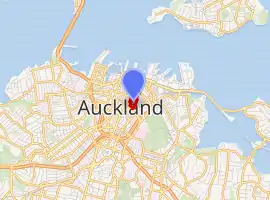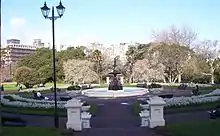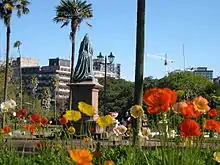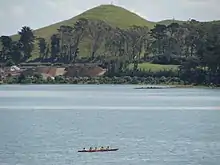Albert Park, Auckland
Albert Park is a public park in central Auckland, bounded by Wellesley Street East, Princes Street, Bowen Avenue and Kitchener Street. From the entrance at the corner of Bowen Ave and Kitchener St, sealed footpaths climb steeply through native trees to the large flat area at the summit, where a formal layout of paths and flower gardens encircle a fountain.
| Albert Park | |
|---|---|
 The band rotunda near the south end of the park | |

| |
| Type | Urban park |
| Location | Auckland, New Zealand |
| Coordinates | 36.8507°S 174.7675°E |
| Created | 1880s |
| Operated by | Auckland Council |
| Status | Open all year, 24 hours |

History
Albert Park occupies much of the site of the Albert Barracks, one of Auckland's early European military fortifications, which in turn was built on the previous site of Te Horotiu pa. The barracks consisted of a number of wooden and masonry structures standing in an enclosed area surrounded by a rock fortification built of the local volcanic stone. A portion of this wall remains visible in the adjacent University of Auckland grounds, and is registered by Heritage New Zealand as a Category I historic place.[1]
The Park was laid out in the 1880s and originally had commanding views over the city and harbour. The view now is of modern office blocks, except where mature trees have hidden the buildings. The Park contains a number of interesting specimen trees dating from the 1880s to the first World War. A caretaker's residence was provided which still stands on the eastern side of the part adjacent to Princes Street. After 1906 this Gothic-styled cottage was occupied by the City Park Superintendent Thomas Pearson, who died here in 1931. It is currently empty.
Features

The design of the park was the result of a public competition and follows a formal layout with a main north-south axis. To the north of the axis is a bronze statue by Francis J Williamson of Queen Victoria (1897); to the south is a bandstand (James Slator 1901). Between them is a large cast iron fountain imported from Great Britain in 1881 which forms the centrepiece of the park. The fountain is distinguished by statues of dolphins ridden by cherubs blowing horns that spout water. The fountain is surmounted by a generic female figure that also has a horn spouting water.
The statue of Queen Victoria was one of several similar sculptures installed by municipal authorities throughout the British Empire following the monarch's Diamond Jubilee in 1897. This sculpture was cast in London and unveiled with considerable ceremony here as part of the Jubilee celebrations. The red granite pedestal is intact but the ensemble originally included a massive cast iron ornamental fence that has been removed.
There are several other artworks and memorials in the park, including a marble Boer War memorial, and an over life-size marble statue also by F J Williamson of Sir George Grey (1904) that was relocated here from its original site outside the Auckland Town Hall. There are two Edwardian marble edifices near the band rotunda, one being Andrea Carlo Lucchesi's Love breaking the sword of hate (1900) and the other a memorial drinking fountain. Many of these memorials and artworks can be seen in the numerous images of Albert Park printed as postcards since the early 20th century.[2]
Near the flagpole and Boer War Memorial on the north side of the park are two large field guns that were once part of the defense system set up during the Russian Invasion Scare of the 1880s. Near the Princes Street exit in front of the University of Auckland clock tower is a large floral clock that was constructed in 1953 with funds donated by Robert Laidlaw, founder of the Farmers department store chain, (this was intended to commemorate the 1953 visit of Queen Elizabeth the Second). Near the Art Gallery is a large modern sculpture from the 1990s called 'Tilt'. Surprisingly an operating Victorian Gas Lamp survives in the Park, on the stairs leading from Kitchener Street.
Beneath the park are the extensive Albert Park tunnels. They were built in 1941 to be used as air raid shelters, but were decommissioned and sealed up before World War II ended. The tunnels were largely forgotten for many years and, although periodically over the last decades there are calls for them to be opened up, nothing has happened (probably purely for logistical reasons). There were large tunnel entrances at the top of Victoria street, adjacent to the Art Gallery on Wellesley Street and from Constitution Hill. One can still be seen on Kitchener Street between Courthouse and Bacons Lane.
Geography
Albert Park lies beside the site of one of the earliest volcanoes in the Auckland volcanic field, which erupted beneath the current Victoria Street carparks and the 'Metropolis' hotel/apartments entrance building (the former Auckland District Court). While primarily a very small scoria cone, it also sent a lava flow into the Queen Street valley, and coated the pre-existing sandstone Albert Park ridge with ash (Albert Park is not itself the location of a volcano).
The lava flow partially dammed the stream running down the Queen Street valley creating a swamp upstream. This flat sector of the valley can now be recognised between Wellesley and Victoria Streets. The stream was known as Waihorotiu (meaning - Waters of the crumbling rocks) indicative of the land subsidence which partly blocked the Queen Street valley, creating a swampy area which is now Aotea Square. The diminutive scoria cone was substantially quarried away for roading and building material during the establishment of the city in the late 19th century, although a slight rise in Kitchener Street adjacent the carparks remains as the only physical remnant now visible.
Notes
- "Albert Barracks Wall". Register of Historic Places. Heritage New Zealand. Retrieved 12 March 2016.
- See the compilation of images by Jeff Pyle Archived 2012-08-05 at the Wayback Machine
Gallery
 View from Princes Street
View from Princes Street View towards Wellesley Street
View towards Wellesley Street Floral clock
Floral clock Sir George Grey statue
Sir George Grey statue South-east view
South-east view North-west view
North-west view Auckland Lantern Festival 2009
Auckland Lantern Festival 2009 Two phoenix palms frame a view of the Sky Tower
Two phoenix palms frame a view of the Sky Tower Albert Park in early summer
Albert Park in early summer
External links
| Wikimedia Commons has media related to Albert Park, Auckland. |
- Albert Park. Description of the park and its history. Auckland Council. Assessed 2013-03-31.
- Plans of the tunnels, and a tale of exploration
- Auckland City's Management Plan for Albert Park
- Purpose of the Auckland Improvement Trust Amendment Act 2001
- Auckland Regional Council's Volcanic Hazards website
- Archaeopedia New Zealand
- Albert Park Fountain 3D
- Photographs of Albert Park held in Auckland Libraries' heritage collections.
